Hirosaki Castle
-Huge castle with original main tower at northern frontier-
Overview
Name: Hirosaki castle (Hirosaki-jo)
Alias: Takaoka-jo (Takaoka castle)
Place: Shimo-Shiroganecho Hirosaki city, Aomori
Location: 40.607578890821344, 140.4636941585767
Type: Flat Castle
Built: 1611
Remaining remnants: Main tower, turrets, gates, stone walls and moats
Title: 100 famous Japanese castles
Hirosaki castle (弘前城) is located at the center of Hirosaki city, a central area of western part of Aomori prefecture. Hirosaki city places at the south edge of Hirosaki plain, a large plain at the west half of Aomori prefecture, along with Nanbu plain which is another large plain at the east part of the prefecture separated by Hakkodasan mountains. Hirosaki area is an important area of communication which is a crossing point of roads from southward such as Akita area or Morioka area, eastward from Hachinohe area, and northward from Aomori area.
As Tsugaru area is distant from central area, precise history of Hirosaki area is not so clear. In 13th century, Ando clan was appointed as a governor of this area, and located at Tosaminato port at the west coast of Tsugaru peninsula, almost north edge of main land of Japan. In medieval era, Pacific Ocean side coast of Tohoku region was not so developed, and maritime trade was mainly performed at Sea of Japan side because of shorter distance, good ports at coast, and closeness to Kyoto city.
Ando clan was appointed as a regional governor of current Hokkaido island from Kamakura Shogunate, and governed vast area from north part of current Akita prefecture, western half of Aomori prefecture and South edge of Hokkaido island from Tosaminato port. Ando clan got wealth from trade between mainland and Hokkaido island, and prospered about 200 years. Their base Tosaminato was a huge city of two kilometer long, and was regarded as one of the major ports of Japan along with Hakata port (Fukuoka prefecture).
But in the latter half of 15th century, Nanbu clan which was the lord of Naubu area, east half of Aomori prefecture) gradually grew their power and stated expansion. After battle continued decades, Nanbu clan expelled Ando clan from Tsugaru area, and Ando clan escaped to Hokkaido island. In the former half, Tsugaru plain was divided by local lords such as Oura clan at Oura castle or Kitabatake clan at Namioka castle under the effect of Nanbu clan.
Since the middle of 16th century Tamenobu Oura (1550-1608, later named as Tamenobu Tsugaru) started to expand this territory. Oura clan is said as originally a branch family of Nanbu clan, but Tamenobu himself is said as a adopted son from other clan. Anyway Tamenobu became the leader of Oura clan around 1570 and nominally belonged to Nanbu clan.
Even though being born at the marginal area of main land Japan, Tamenobu had a strong ambition and intelligence. Tamenobu communicated to Yoshiaki Mogami (1544-1614), a warlord of Dewa province (Yamagata prefecture), to acquire information on central area, and later sent a letter to central ruler Nobunaga Oda (1534-1582).
Around 1570, Nanbu clan became its peak period under its leader Harumasa Nanbu (1517-1582). Territory of Nanbu clan spread over current Aomori prefecture and Iwate prefecture, and was praised as it took time of changing moon from crescent to full moon to travel Nanbu territory.
But Nanbu clan was originally a mixture of branch families and important retainers, and as Harumasa did not have his own son dispute on the successor was emerging. Furthermore, Tsugaru region was distant from Nanbu area, and was guarded by steep mountain. Utilizing this condition, Tamemobu started his action to become an independent lord.
In 1571, Tamenobu suddenly attacked Ishikawa castle near Oura castle and killed Takanobu Ishikawa (1495?-1571?). Takanobu was a close relative of Harumasa Nanbu, and pillar of Naubu clan at Tsugaru region. Nobunao Nanbu (1546-1599), next leader of Harumasa and which established Naubu clan as a feudal lord, was son of Takanobu, and since then Naubu clan and Tsugaru clan became a fatal enemy. Next in 1575 Tamemobu attacked Daikouji castle which was the entrance where was a gateway into Tsugaru region from Naubu region, and shut the supply line from Naubu clan.
In 1578, Tamenobu ruined Namioka clan, which was a descendant of high class noble Kitabatake clan located at Namioka castle, and captured middle part of Tsugaru plain. Furthermore Tamenobu destroyed other small lords around him, and finally seized Tsugaru plain by 1588.
Just at that time, authority of central ruler was about to reach to north part of main land Japan. Central ruler Hideyoshi Toyotomi (1537-1598) subdued Shimazu clan which seized Kyushu island in 1587, and was waiting for a change to attack Hojyo clan which kept almost all part of Kanto region.
Under such situation, among Naubu clan was confused by internal conflicts after the death of Harumasa, Tamenobu instantaneously sent an envoy and proposed to subordinate to Hideyoshi as a lord of Tsugaru region. Of course Naubu clan strongly resisted to this action, but as Tamenobu already had a relationship with administrative staff of Toyotomi government such as Mitsunari Ishida (1560-1600), independence of Tamenobu was approved and he became the feudal lord of Tsugaru region.
After the death of Hideyoshi in 1598, the battle of Sekigahara occurred between Ieyasu Tokugawa (1543-1616), the largest lord under Toyotomi government and who aimed at next hegemony, and Mitsunari Ishida who tried to keep Toyotomi government. Tamenobu supported Ieyasu and kept his house, but after the battle Tamenobu secretly kept the relative of Mitsunari who was killed after the battle. It might expose Tsugaru clan to a danger, but it is said that Tamenobu felt indebted to Mitsunari who supported independence of Tsugaru clan.
Tamenobu who survived as a feudal lord of Hirosaki domain under Edo Shogunate decided to build a new castle at Hirosaki and started construction in 1604. The place of castle locates at the north edge of long height continues from southward, and being surrounded by Iwakigawa river and its tributary Tsuchibuchigawa river, it is a good place to build a castle. After seven years work, current Hirosaki castle was completed.
As a newly built castle, Hirosaki castle has a sophisticated plan. Central area of Hirosaki castle is a rectangular area of 200 meter long and 100 meter width, at the edge of river cliff facing westward. Entrance to central area was made at north line and south line, and there were buffer areas to guard these entrance. North buffer area is called as Kitanokaku, and in the corner of this part there was a secret area called as Yakagagami. There was a temple only used by a family of the lord, and it is said that a statue of Hideyoshi Toyotomi was secretly placed at this temple.
Outside of this central part, secondary area spread from east to south. Furthermore, outer part such as Nishinomaru or Sannomaru protected north, east and south front of the castle. As westward was a lower place, two layers of water moat guarded this direction. Total size of Hirosaki castle was about 1,000 meter long and 400 meter width, and compared with the income of Hirosaki domain it was quite a large castle.
Compared with its size, buildings of Hirosaki castle were limited and simple. At first there were one five story main tower at the southwestern corner of central area, but it was lost by fire only 20 years after construction. Other than this original main tower, there were only five turrets and ten gates, and most part of the castle was guarded only by clay wall and fences. Furthermore, to spare time and cost, many buildings were moved from existing castles. But to compensate small number, each corner turrets were three layer building, although majority of corner turrets of other castle were single floor or second floors.
Current remaining main tower of Hirosaki castle was built in 1810. Tsugaru domain was awarded its service of patrolling Hokkaido island, and admitted to build a new tower. Officially it was a corner turret and substitute for main tower, but design of this tower was far apart from other corner turret and equipped dignity as a main tower.
This main tower is a nearly square shaped rectangle floor, and although it was built in late period of Edo era, it has a traditional exterior. On the south and east side which face outside there is no window and only crenels, and projection area covered by decoration roof was built at first and second floor of both side. Although being not large, black colored roof and folding wall of the castle has a mannish impression to the visitor.
Hirosaki domain suffered from recurring internal conflicts and famines, but survived during Edo era. At the Meiji revolution war, Hirosaki domain supported Meiji new government in advance of its rival Morioka domain of Nanbu clan and kept good position, same as their ancestors.
Subsequent Meiji revolution site of Hirosaki castle was used as a military base. As Aomori city became the center of Aomori prefecture considering balance of Hirosaki plain and Nanbu plain and its importance as a port to Hokkaido island, shape of Hirosaki castle was well kept without being broken by development. Furthermore originally there were only limited building, many buildings were kept.
Now one main tower, three corner turrets and five gates remain as original in the castle, and it is quite valuable in Tohoku region where many castles were lost in Meiji revolutionary war or WW2. Combination of water moats, clay walls and simple exterior buildings well keep the atmosphere of castle in Eastern Japan, which was mostly lost in Kanto region. Now cherry blossom are planted across the site, and in spring reason beautiful view of buildings and flowers please the eye of visitors.
20 minutes walk from JR East Ou Honsen line Hirosaki station, It is convenient to hire rental bicycle at Hirosaki Station. 20 minutes drive from Tohokudo Expressway Owani Hirosaki interchange.
Type: Flat Castle
Built: 1611
Remaining remnants: Main tower, turrets, gates, stone walls and moats
Title: 100 famous Japanese castles
Brief History
Hirosaki castle (弘前城) is located at the center of Hirosaki city, a central area of western part of Aomori prefecture. Hirosaki city places at the south edge of Hirosaki plain, a large plain at the west half of Aomori prefecture, along with Nanbu plain which is another large plain at the east part of the prefecture separated by Hakkodasan mountains. Hirosaki area is an important area of communication which is a crossing point of roads from southward such as Akita area or Morioka area, eastward from Hachinohe area, and northward from Aomori area.
Tsugaru area in medieval era
As Tsugaru area is distant from central area, precise history of Hirosaki area is not so clear. In 13th century, Ando clan was appointed as a governor of this area, and located at Tosaminato port at the west coast of Tsugaru peninsula, almost north edge of main land of Japan. In medieval era, Pacific Ocean side coast of Tohoku region was not so developed, and maritime trade was mainly performed at Sea of Japan side because of shorter distance, good ports at coast, and closeness to Kyoto city.
Ando clan was appointed as a regional governor of current Hokkaido island from Kamakura Shogunate, and governed vast area from north part of current Akita prefecture, western half of Aomori prefecture and South edge of Hokkaido island from Tosaminato port. Ando clan got wealth from trade between mainland and Hokkaido island, and prospered about 200 years. Their base Tosaminato was a huge city of two kilometer long, and was regarded as one of the major ports of Japan along with Hakata port (Fukuoka prefecture).
But in the latter half of 15th century, Nanbu clan which was the lord of Naubu area, east half of Aomori prefecture) gradually grew their power and stated expansion. After battle continued decades, Nanbu clan expelled Ando clan from Tsugaru area, and Ando clan escaped to Hokkaido island. In the former half, Tsugaru plain was divided by local lords such as Oura clan at Oura castle or Kitabatake clan at Namioka castle under the effect of Nanbu clan.
Rise of ambitious general
Since the middle of 16th century Tamenobu Oura (1550-1608, later named as Tamenobu Tsugaru) started to expand this territory. Oura clan is said as originally a branch family of Nanbu clan, but Tamenobu himself is said as a adopted son from other clan. Anyway Tamenobu became the leader of Oura clan around 1570 and nominally belonged to Nanbu clan.
Even though being born at the marginal area of main land Japan, Tamenobu had a strong ambition and intelligence. Tamenobu communicated to Yoshiaki Mogami (1544-1614), a warlord of Dewa province (Yamagata prefecture), to acquire information on central area, and later sent a letter to central ruler Nobunaga Oda (1534-1582).
Around 1570, Nanbu clan became its peak period under its leader Harumasa Nanbu (1517-1582). Territory of Nanbu clan spread over current Aomori prefecture and Iwate prefecture, and was praised as it took time of changing moon from crescent to full moon to travel Nanbu territory.
But Nanbu clan was originally a mixture of branch families and important retainers, and as Harumasa did not have his own son dispute on the successor was emerging. Furthermore, Tsugaru region was distant from Nanbu area, and was guarded by steep mountain. Utilizing this condition, Tamemobu started his action to become an independent lord.
Unite of Tsugaru region
In 1571, Tamenobu suddenly attacked Ishikawa castle near Oura castle and killed Takanobu Ishikawa (1495?-1571?). Takanobu was a close relative of Harumasa Nanbu, and pillar of Naubu clan at Tsugaru region. Nobunao Nanbu (1546-1599), next leader of Harumasa and which established Naubu clan as a feudal lord, was son of Takanobu, and since then Naubu clan and Tsugaru clan became a fatal enemy. Next in 1575 Tamemobu attacked Daikouji castle which was the entrance where was a gateway into Tsugaru region from Naubu region, and shut the supply line from Naubu clan.
In 1578, Tamenobu ruined Namioka clan, which was a descendant of high class noble Kitabatake clan located at Namioka castle, and captured middle part of Tsugaru plain. Furthermore Tamenobu destroyed other small lords around him, and finally seized Tsugaru plain by 1588.
Just at that time, authority of central ruler was about to reach to north part of main land Japan. Central ruler Hideyoshi Toyotomi (1537-1598) subdued Shimazu clan which seized Kyushu island in 1587, and was waiting for a change to attack Hojyo clan which kept almost all part of Kanto region.
Under such situation, among Naubu clan was confused by internal conflicts after the death of Harumasa, Tamenobu instantaneously sent an envoy and proposed to subordinate to Hideyoshi as a lord of Tsugaru region. Of course Naubu clan strongly resisted to this action, but as Tamenobu already had a relationship with administrative staff of Toyotomi government such as Mitsunari Ishida (1560-1600), independence of Tamenobu was approved and he became the feudal lord of Tsugaru region.
Construction of Hirosaki castle
After the death of Hideyoshi in 1598, the battle of Sekigahara occurred between Ieyasu Tokugawa (1543-1616), the largest lord under Toyotomi government and who aimed at next hegemony, and Mitsunari Ishida who tried to keep Toyotomi government. Tamenobu supported Ieyasu and kept his house, but after the battle Tamenobu secretly kept the relative of Mitsunari who was killed after the battle. It might expose Tsugaru clan to a danger, but it is said that Tamenobu felt indebted to Mitsunari who supported independence of Tsugaru clan.
Tamenobu who survived as a feudal lord of Hirosaki domain under Edo Shogunate decided to build a new castle at Hirosaki and started construction in 1604. The place of castle locates at the north edge of long height continues from southward, and being surrounded by Iwakigawa river and its tributary Tsuchibuchigawa river, it is a good place to build a castle. After seven years work, current Hirosaki castle was completed.
Structure and buildings of Hirosaki castle
As a newly built castle, Hirosaki castle has a sophisticated plan. Central area of Hirosaki castle is a rectangular area of 200 meter long and 100 meter width, at the edge of river cliff facing westward. Entrance to central area was made at north line and south line, and there were buffer areas to guard these entrance. North buffer area is called as Kitanokaku, and in the corner of this part there was a secret area called as Yakagagami. There was a temple only used by a family of the lord, and it is said that a statue of Hideyoshi Toyotomi was secretly placed at this temple.
Outside of this central part, secondary area spread from east to south. Furthermore, outer part such as Nishinomaru or Sannomaru protected north, east and south front of the castle. As westward was a lower place, two layers of water moat guarded this direction. Total size of Hirosaki castle was about 1,000 meter long and 400 meter width, and compared with the income of Hirosaki domain it was quite a large castle.
Compared with its size, buildings of Hirosaki castle were limited and simple. At first there were one five story main tower at the southwestern corner of central area, but it was lost by fire only 20 years after construction. Other than this original main tower, there were only five turrets and ten gates, and most part of the castle was guarded only by clay wall and fences. Furthermore, to spare time and cost, many buildings were moved from existing castles. But to compensate small number, each corner turrets were three layer building, although majority of corner turrets of other castle were single floor or second floors.
Current remaining main tower of Hirosaki castle was built in 1810. Tsugaru domain was awarded its service of patrolling Hokkaido island, and admitted to build a new tower. Officially it was a corner turret and substitute for main tower, but design of this tower was far apart from other corner turret and equipped dignity as a main tower.
This main tower is a nearly square shaped rectangle floor, and although it was built in late period of Edo era, it has a traditional exterior. On the south and east side which face outside there is no window and only crenels, and projection area covered by decoration roof was built at first and second floor of both side. Although being not large, black colored roof and folding wall of the castle has a mannish impression to the visitor.
Afterward of Hirosaki domain and Hirosaki castle
Hirosaki domain suffered from recurring internal conflicts and famines, but survived during Edo era. At the Meiji revolution war, Hirosaki domain supported Meiji new government in advance of its rival Morioka domain of Nanbu clan and kept good position, same as their ancestors.
Subsequent Meiji revolution site of Hirosaki castle was used as a military base. As Aomori city became the center of Aomori prefecture considering balance of Hirosaki plain and Nanbu plain and its importance as a port to Hokkaido island, shape of Hirosaki castle was well kept without being broken by development. Furthermore originally there were only limited building, many buildings were kept.
Now one main tower, three corner turrets and five gates remain as original in the castle, and it is quite valuable in Tohoku region where many castles were lost in Meiji revolutionary war or WW2. Combination of water moats, clay walls and simple exterior buildings well keep the atmosphere of castle in Eastern Japan, which was mostly lost in Kanto region. Now cherry blossom are planted across the site, and in spring reason beautiful view of buildings and flowers please the eye of visitors.
Important notice:
From June 2015 to 2023, repair construction of stone walls of central area is performed. Main tower is moved to inside of central area in one year, and stone wall will rebuilt. Visitors might be able to see inside of main tower after 2016, but view of the castle might be different from original style.Access
20 minutes walk from JR East Ou Honsen line Hirosaki station, It is convenient to hire rental bicycle at Hirosaki Station. 20 minutes drive from Tohokudo Expressway Owani Hirosaki interchange.
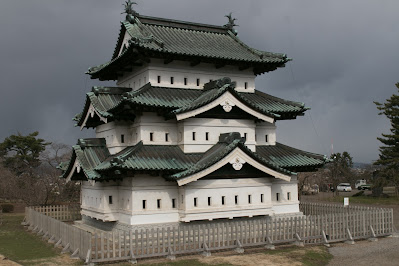
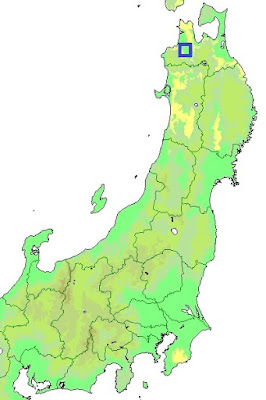















































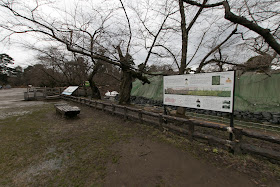



















































































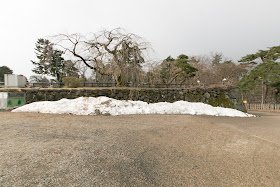

























































































































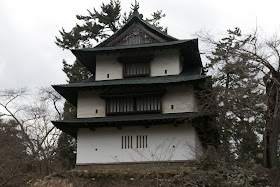

















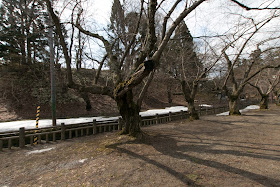




































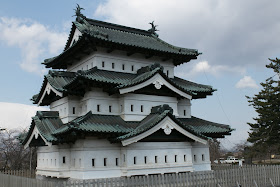





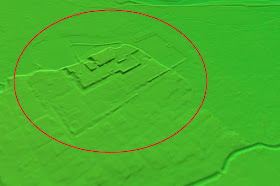
No comments:
Post a Comment